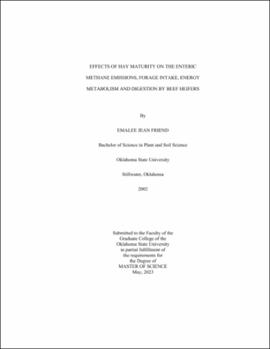| dc.description.abstract | Ruminants are a primary source of food security and play an essential part in sustainable agriculture. Ruminants consume fibrous feedstuffs and convert them to highly nutritional food and consumable products. While doing this, ruminants produce greenhouse gases that contribute to climate change. Enteric methane is produced as a byproduct of the fermentation of ruminants. Enteric methane production is also an energy loss to the ruminant system. Forage quality has an impact on the amount of enteric methane that is produced. As forages mature, nutritive value declines with declining crude protein and increasing fiber content. Enteric methane production tends to increase as the quality of forages decline. Due to the impact enteric methane production has on the environment and to the producer, it is important to research ways to mitigate enteric methane production. Globally, wheat is grown on more than 240 million hectares. Along with grain it provides pasture, hay, silage, and straw as feed for ruminants. Therefore, our objective of this experiment was to investigate the effects that feeding heifers long-stemmed wheat hay cut at three different maturities had on intake, digestion, metabolism, and enteric methane emission by beef heifers. Twelve heifers were used in a 34-day feeding experiment fed over three 7-day periods. Heifers were randomly assigned to 1 of 3 maturities including wheat hay cut at the stem elongation stage, wheat hay cut at the booting stage, and a mature wheat hay cut at the milk grain stage. Hay was fed at ad libitum plus a daily supplement of pellets were offered via an automated head-chamber system that measures carbon dioxide and methane emissions, and oxygen consumption while supplement was consumed. The results of our experiment showed that dry matter intake decreased linearly as the wheat matured. Hay maturity had a significant negative linear effect on metabolizable energy intake and digestible energy intake. As the hay matured, heat production decreased linearly. Hay maturity had a decreasing linear effect on total enteric methane emissions but did not have an effect on methane yield as expressed as g of methane/kg of DMI. However, carbon dioxide emissions and oxygen consumption decreased linearly as wheat matured. Digestibilities of the immature, intermediate, and mature hay were 76.22%, 68.01%, and 58.57%, respectively. These results indicate that as forage matures it has a negative effect on dry matter intake, carbon dioxide emissions, oxygen consumption, heat production, metabolizable energy intake and digestible energy intake, but did not have an effect on methane yield. | |
